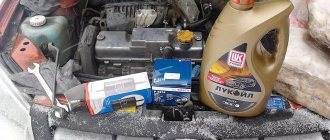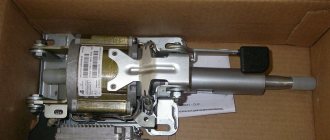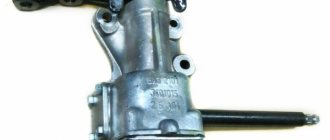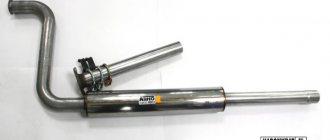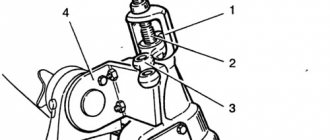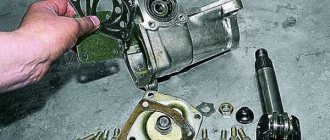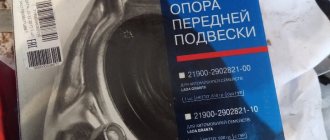How to fix
The main reason for knocking is that the cardan located at the bottom of the engine shield is weakened.
The second driveshaft is not visible; it is located behind the cover of the electric power steering control unit. To make it easier to tighten and see the mechanism, you need to remove the steering wheel cover. The photo shows the electric amplifier and its electronics unit.
I removed the metal box that is held in place with screws. They were tightened very tightly; I had to use a special power screwdriver with a ratchet. Behind it you can see the second cardan, on which you need to check the tightness, which I did.
Surprisingly, nothing was loosened after 45 thousand miles. On other cars with lower mileage, the driveshafts usually weaken earlier.
Within a few minutes you can get rid of the knocking sound of the steering gearbox. Of course, this will not help in all cases. But before tightening the rack, try checking the cardans.
Write how you eliminated extraneous noise, squeaks and knocks. What was their reason and what happened. I wish you good luck and goodness!
Source
Results of my work
After driving around, I finally realized that all the problems had been fixed. The replacement itself in the salon would have cost much more, but at home everything cost about one and a half thousand rubles.
This level of repair is not for everyone, although it is not the most difficult; many are afraid of breaking something or putting it together incorrectly; not everyone can be a car mechanic. There are many nuances, as in all car repair operations. But I did it perfectly the first time, so you can try it too, I’m sure that most novice auto mechanics will succeed.
We remove the knock of the steering shaft on Lada Granta, Kalina and Priora
We noticed that when driving on uneven roads (for example, gravel), vibration is strongly transmitted to the steering wheel. It is also possible that a knock may occur, but it is not the steering rack that is rattling. The cause of the rattling may be play in the steering shaft. It is proposed to solve the problem with the help of a simple modification, which was used on VAZ 2108-15 cars.
Knocking and rattling noises appear due to gaps in the mating parts. To eliminate them, insert a rubber cube (dimensions 22x22x22 mm) into the universal joint of the intermediate steering shaft. It is cut out from the rubber bumper of the rear suspension of the “classic”.
To install the rubber part into the steering shaft, you don’t need to remove anything, just crawl under the panel and look for the connection above the brake pedal. To fit the cube into a narrow space, you will need to lubricate it (for example, WD-40) and use a clamp or jack.
For owners of Lada Granta and Kalina models with ESD, there is an alternative to this modification - install a steering driveshaft without knocking (catalog numbers: 11186-3422092-00, 21230-3401085-00). Let us remind you that in some cases the causes of knocking can be eliminated by tightening the steering rack or steering shaft bolt. Have you encountered such a modification? What effect did you feel after installing the rubber cube?
Source
Why might the driveshaft break?
The most common reason is constant use of the car on uneven roads, driving over potholes and ruts. During such shaking, a large load falls on this moving part.
The second reason may be oil leakage due to a leaking oil seal. Because of the oil, the sealing ring https://podshipnik-mo.ru/koltsa-uplotnitelnyye hardens, and a gap appears between the oil seal and the rod. Or the mirror on the driveshaft connection is broken, and various roughness and burrs appear on the rod. In this case, the splines will have to be changed or sanded (but this is a temporary remedy).
Test before diagnosis: when does the murmur appear?
If it makes annoying noise while driving, find out where and when it happens:
- At low or high speed.
- On roads with good coverage or uneven areas, for example, when driving through potholes and various bumps.
- When turning with the steering wheel turned all the way or near the zero mark.
- In a sharp or smooth turn.
When the car is stationary, it is enough to pull the steering wheel, rocking the wheels from side to side. If there are knocks, there is no need to go anywhere. Take a partner so that you have someone to rotate the main control left and right, and you put your hand on all the joints in the “steering”. Now we’ll figure out what exactly to feel.
Replacing the steering shaft in Lada Kalina
One of the largest Russian enterprises involved in the development of passenger cars is AvtoVAZ. During the period when AvtoVAZ existed, many cars have already been produced and released. One of the released models is the VAZ1118, and this is the very first version of the Lada Kalina. The first Lada Kalina model began production in 2004 and ended in 2011. Although the production of this car model ceased a couple of years ago, the car itself did not disappear from Russian roads and they are still found on the roads of many Russian cities.
Rack adjustment
Before installing the rack and rods back, it is necessary to set the gaps of the gear connection. Please note that it is better to immediately replace the thrust nut with a new one. Set the rack to the middle position, as if the wheels were straight. For adjustment, a special clock-type indicator mechanism is used. We start rotating the gear shaft and measure the indicator readings.
If the value is 0.05 mm, then the adjusting nut should be tightened to the same amount. After the steering rack adjustment is completed, check the ease and uniformity of movement along the entire length of the rack stroke. Provided that everything is done accurately, you should fix the position of the adjusting nut by performing special core punching with a punch. When all the work has been completed, you can begin to reinstall the steering mechanism on the Lada Granta. After the mechanism has been installed back on the car, you should, even before starting to drive with the car stationary, turn the steering wheel, checking the uniformity of rotation. A check that will reveal that there is no knocking can only be done while driving on a rough road.
Steering malfunctions usually occur due to insufficiently frequent preventive inspections. If the owner has missed the appearance of minor leaks in the steering mechanism, loss of integrity of the protective covers, then the likelihood that a knock will soon appear in it is quite high. Therefore, it is important to carry out annual diagnostics.
Removing the steering mechanism of the Lada Granta is necessary in the event of a breakdown of the steering mechanism; as a rule, plastic parts fail (wear out). As a result, the steering loses its “sharpness” of control, and knocking is heard in the steering when driving over uneven surfaces. Removal of the steering mechanism is carried out according to the following instructions.
How do you know when it's time to change the driveshaft?
Signs of its malfunction are noticeable, but have little effect on the quality of movement, which is why many car owners ignore the problem until the last moment, almost to the point of losing control of the car. You should not ignore signs of a malfunction; if at least two appear at once, you need to immediately carry out diagnostics. What are the signs of wear or breakage?
- When driving at a speed of more than 80 km/h, the steering wheel resists when turning, making it more difficult to turn.
- The steering wheel turns unevenly and jerks when turning, which puts additional stress on the hands.
- The steering wheel has become less sensitive, and the turning of the wheels responds to control late.
- The appearance of noticeable play (free movement of wheels with stable fixation of the steering wheel).
- Vibration of the driveshaft. Check with a tachometer to see if this vibration appears at one speed or at different speeds. Only vibration at different speeds indicates problems with the cardan; if it occurs at different speeds, but at the same frequency, then you need to think about how to change the steering cardan on a grant, because the speed of the cardan was different at that time.
- Knocking and grinding noises in the steering wheel, especially when driving on rough roads.
We have a knocking sound when the steering wheel is rocking in place
The most vulnerable connection is the ball joints in the tie rod ends. Inspect them out of turn. The remaining pairings are tested in order:
- Electric power steering – mounting bracket (pressure bolts are loose).
- Emergency folding system (on older machines).
- Cardan between the rack and the column.
- Rail.
- Rods are a rack and pinion mechanism.
Some nodes can be checked in alternative ways:
- Rod ends. Jack up the wheel, grab it at the 3 and 9 o'clock positions and rock it from side to side. There should be no backlash or sounds. Diagnose both sides one by one.
- A system that is triggered in case of an accident. Press the steering wheel down and jerk it left and right. If the noise stops, the cause has been found.
- Kardanchik. A slight wear in the needle bearing is indicated by a knocking sound when turning the steering wheel in motion; on a straight line there is silence.
- Rail. If when driving it knocks only on a straight line, but not when turning and turning, the middle position of the gear is worn out. For replacement.
Advice! Do not tighten a worn rack. The play will stop, but in extreme positions the steering wheel will rotate tighter. Its arbitrary return to the zero position will become impossible.
If you hear a noticeable knocking noise when you move the steering wheel left to right: diagnosis
Probable Causes
If an audible knocking sound in the front suspension when turning the steering wheel indicates wear in its constituent parts, then an extraneous clicking sound when the steering wheel rocks requires inspection of other structural elements. As a rule, the problem lies in the vehicle control system.
Statistics show that there is something to knock in the “steering wheel”. Any pairing may come under suspicion:
- Gap in the fit between the steering tip and the strut.
- Excessive play in the steering rack.
- There is a problem with the steering shaft driveshaft.
- Free movement of the steering wheel on the shaft.
- Gap in steering rod joints.
These parts are present in the design of any car. Knowing the location of all the landings, it remains to identify the defective pair.
For your information. Some old foreign cars have a folding steering column assembly, which breaks under the influence of a critical load that occurs during an accident. He can knock too.
How to identify knocking: expert methods
The classic approach to identifying a faulty unit will be explained in any garage. Its essence is trivial: just ask the assistant to shake the steering wheel and at this time put his hand on the mentioned connections.
Steering rack
However, in some situations this technology loses its relevance. In particular, it will not be possible to identify a defect in the mechanism using this method. To identify a problem in the gear-rack engagement, it is necessary to carry out the following experiment:
- If there is power steering (hydraulic booster): a knocking sound appears when the steering wheel is rotated on a car with the engine turned off, but when the engine is running, there is no knocking at the place.
- There is no power steering: drive along a road section with a changeable direction - when you swing the steering wheel left to right, a knock is heard, but when turning, the rack does not knock due to the small wear of the working surfaces of the gearing in the extreme positions.
For your information. It is not recommended to tighten a worn rack. One of the owners of Hyundai Solaris performed this procedure and after 10,000-12,000 km the steering wheel began to bite. An autopsy showed that the mechanism was beyond repair.
Emergency system
It is also possible to determine experimentally whether the steering column folding assembly is the cause of the knocking. It is enough to swing the “steering wheel” to the sides, while simultaneously pressing it to the bottom. The sound disappeared - the problem is in the emergency system.
How to tighten the steering rack on a Lada Granta
So, there are two ways you can go:
- The easiest and fastest way is to tighten the rack using a special key, inserting it into the hole where the steering rod passes on the left side of the Granta body.
- The second method is longer - it is suitable if the hand does not fit into the hole in the body from the wheel side. In this case, you will have to remove the battery and its platform to get to the adjusting nut.
So, with the first method everything is clear; as for the second, let’s consider it in more detail. First of all, unscrew and remove the terminals from the car battery.
Then we remove the battery and proceed to dismantling its platform.
Now that the platform has been removed, you need to get to the adjusting nut from the inside of the steering rack housing.
The rack is tightened clockwise, take into account the fact that it is in an inverted state, so the movement will be counterclockwise.
Please note that to adjust the rack on a Grant, you need to buy a special key, which is designed for the VAZ 2110 rack. Its price is no more than 150 rubles, and sometimes they are sold combined: on one side for the rack, on the other for the timing rollers.
Lada Granta was originally created as an inexpensive car. Actually, that’s why it became one of the most popular cars on the roads. The manufacturer tried to introduce both proven and new elements into the design. But they have their drawbacks. The Lada Granta steering rack can present various surprises during operation. It is useful for the owner of a domestic car to understand the structure of many components.
Analysis of typical complaints
The advice given at the beginning, to understand when the tapping occurs, makes it somewhat easier to find the cause. But this recommendation is effective only with a comprehensive diagnosis. For example, the mere fact of clanking in the pits is not enough; you need to listen to what is happening when the wheels are turned and whether there are any sounds in place.
If the test is done, go through common complaints.
- The noise only appears when the steering wheel is turned. If nothing is transmitted to the steering wheel, then see “ball” in more detail. Perhaps it is not tightly attached to the steering knuckle or lever. For example, bolts are often forgotten to be tightened during wheel alignment.
- The knock comes from the steering wheel. This is either a rack or a cardan on the shaft. If this only occurs on washboards and other irregularities, inspect the control shaft telescopic connection. Pay attention to the rack and pinion mechanism - the nuts securing it to the subframe or body may be loose.
- The rattle is only on the straight line, quiet in turns. Rack, cardan, ball joints.
Removing the steering gear
If a knock does occur, the car owner will have to dismantle the mechanism. It is more convenient and faster to carry out this work when the vehicle is on a lift. To carry out the work you will need the necessary tools, which in this case include:
- socket wrench or socket wrench 13;
- flat screwdriver;
- durable knife;
- special 24mm wrench for the steering rack;
- hexagon 6 with wrench.
Before starting work, the battery is disconnected, thereby taking the necessary safety measures. At the initial stage, you need to first loosen the bolts securing the front wheels. The wheels themselves should be left in the “straight” position before lifting the car onto the lift. Next, the steering wheel driveshaft is disconnected from the rack and pinion drive shaft.
This work is carried out from the salon. Therefore, the car is not raised high. The swing rods can now be released by unscrewing them from the swing arms. And as soon as this work is completed, you can begin to dismantle the steering mechanism. Using a 13mm wrench, unscrew the nuts securing it and remove the mounting clamps.
The steering mechanism is removed along with the disconnected steering rods. The next step is to disassemble the removed device. Here you should free the steering rack from all protective covers that are put on the mechanism. For this purpose, cut off all the fixing clamps, which will subsequently need to be replaced with new ones.
How to change the steering cardan
- It is better to roll the car into a pit (at least raise it in front of the car).
- Fix the steering wheel and steering wheel at a right angle. You should also not move or touch the wheels during repairs.
- Remove the front wheel, then unscrew the mounting bolt through the interior. If all operations are carried out correctly, the shaft should come off the steering wheel on its own.
- Remove both casings (top and bottom), make sure there is a boot on the steering shaft. If it is not there, it is better to install it after repair; the part costs no more than 200 rubles.
- Unscrew the bolt on the crosspiece, then the shaft will come off the steering rack on its own.
- Pull down and pull out the shaft. Before repairing, it is better to wash it from dirt and rust; it also affects the quality of movement.
- Secure the shaft in a vice. When it is secured, take the head and knock out the cross on one side to remove the bearing cup. Repeat the same action from the other end.
- Insert a new cross in the same order (one at a time on each side).
- Press in a new crosspiece with a vice (do not overpress).
- Align the cups and roll them with a hammer and chisel.
- Install the new part on the car in reverse order.
Many car owners note when they are looking for where and how to change the steering joint on a Toyota that steering crosspieces from the VAZ-2015 are very suitable for this brand. This greatly simplifies the process of finding parts and reduces the overall cost of repairs.
If we are talking about repairing a “workhorse”, a vehicle engaged in transportation or cargo transportation, repairs or replacements have to be made more often than once every 100 thousand km (due to the condition of most of the roads). Experienced craftsmen who give advice on how to change the driveshaft on the steering wheel of a gazelle note that it is better to install two boots at once so that the sound from the engine is quieter. At the same time, the anthers themselves can also be sealed with foam rubber rings, this significantly reduces squeaks and noise in the car interior.
The driveshaft part itself will cost from 650 rubles for domestic cars and higher for foreign cars. Plus - consumables in the form of boots and nuts.
Non-standard cases
It may not be the suspension or steering parts that are knocking. Shocks and body pecks lead to the movement of units. If they “sit” loosely and there is metal-to-metal contact, clinking cannot be avoided.
- Single dull knock when starting off. See rubber-metal engine or gearbox mounts, transmission driveshaft. For example, when starting, the motor may tilt and hit the spar.
- Rattling on small bumps and in turns. Listen to see if there is a knocking sound in the steering wheel when braking; if there is, the brake caliper guides are worn out.
- Intermittent impact sound, more common when turning at low speeds. Malfunction in the differential of a front-wheel drive vehicle.
Tighten the key bolts and nuts more often, refuel only at gas stations with high-quality gasoline, and remember: a worn CV joint does not knock, but crunches, and does this with the wheels turned out.
Prototypes of “Lada Kalina”
Lada Kalina 1119 hatchback
The first generation of the Lada Kalina model is the Lada Kalina 1119 hatchback, produced from 2006 to 2013 inclusive. The presented Lada Kalina prototype, compared to the sedan and station wagon, has an insufficiently large trunk volume, but if you fold the rear seats, you can carry a fairly large load. There are three basic configurations of this model: luxury, normal and standard. The luxury package includes improved velor upholstery of door panels and seats.
The engine has an eight-valve engine with a volume of 1.6 liters and a modern sixteen-valve unit with a volume of 1.4 liters. Its production began in 2007.
Lighter pistons, cylinder heads, steel intake manifold gaskets and extended connecting rods were used here. Thanks to the modern engine, the Lada Kalina has become more dynamic.
Lada Kalina 1118 sedan
Since 2004, the Lada Kalina model with a sedan body began to be produced, and in 2011, production of the four-wheel drive car ceased. The wheelbase and spacious interior of the sedan are no different from the station wagon and hatchback, and in terms of luggage compartment volume the sedan ranks first. In 2007, the car model received an improved sixteen-valve engine with a lightweight connecting rod and piston group.
Steering shaft cardan Lada Kalina
Lada Kalina 1117 station wagon
Mass production of the station wagon began in 2007, and in 2009 the Lada Kalina was improved. The luggage compartment volume of a station wagon is larger compared to a hatchback and smaller compared to a sedan. The engine has an eight-valve engine with a volume of 1.6 liters and a modern sixteen-valve unit with a volume of 1.4 liters. Reducing engine displacement made the Lada Kalina much more economical and dynamic. There are three basic configurations of this model: luxury, normal and standard.
Diagnostics, repair and reassembly
Before determining why there is a knock in the steering, you should completely disassemble the rack and carry out diagnostics for wear, destruction of components and connections. Disassembly is carried out in this order. Secure the steering rack in a vice, having previously installed spacers made of soft metal or other material. Unscrew the nut securing the mechanism crankcase pipe. The crankcase tube is removed. Remove the clamps securing the pipe bushings and remove them.
Unscrew the adjusting nut. Here you need to use a special 24mm wrench, which has external edges for unscrewing. Sequentially remove the rack stop spring, the sealing ring and the rack stop. Remove the crankcase cover. After removing the bearing cage and sealing ring, remove the rack. The second element of the steering mechanism pair - the gear shaft - is dismantled.
Now you can diagnose the condition of the bearings and sealing rings. After thorough cleaning, the wear of the gear sectors and the condition of the surface of the rack and shaft are assessed. After all, this is where the reason lies that causes the knocking that appears. If necessary, select the necessary parts and replace them.
Before reassembly, all critical connections are lubricated with a special compound. Very often, it is the insufficient amount of lubricant that leads to rapid wear of loaded parts, which violates the previously established clearance. Therefore, even a recently installed rack knocks again.
Assembling the steering mechanism is carried out in the reverse order. For dismantled bearings, you should select the required diameter for cutting pipes, which will help to correctly install the bearings in place. The assembled steering mechanism must be adjusted, since the size of the gap can also determine whether a knock will appear after reinstallation.
What causes a knocking sound in the front suspension of a car when turning the steering wheel while driving?
The chassis and steering mechanism are tightly coupled and perform a single function. One rack command is not enough to turn the wheels in one direction. The racks, which are connected by tips and rods to the rack and pinion assembly, must not only absorb shock, but also rotate around their own axis. This became possible with the introduction of movable mounts.
What's causing the knocking?
When there is a knocking sound when turning the steering wheel while driving, but no extraneous sounds are observed in place, we can firmly state that there are problems with the suspension. Its design includes a sufficient number of connections that use bearings. Any support gradually fails, as evidenced by increased play.
- Strut support bearing.
- Spherical bearing.
- Wheel bearing.
How to identify tapping
You can calculate the knock in the front suspension of a car when turning the steering wheel experimentally. The work is carried out both on site and while moving - it all depends on the location of the defective area:
- The support bearing is checked by rocking the body to the sides: the hand lying on the “support” holder should not feel any play. The second diagnostic method: grab the front wheel spring and ask an assistant to rock the steering wheel to the sides - there should be no knocking.
- A metallic clatter will be heard in the worn out “ball” when bent with a pry bar.
- The hub support makes a dull knock when turning the steering wheel at small angles at a speed of 50-60 km/h.
For information
Often tapping occurs due to worn silent blocks. There are cases when the occurrence of a metallic sound is associated with the loosening of the nut securing the CV joints to the hubs. The hinge itself cannot knock - it is only capable of making a knock. A wheel spun with a small torque also interferes with acoustic comfort.
Inexperienced owners may confuse the symptoms of a steering malfunction with vibrations in the steering wheel when the car is braking. However, there the nature of the problem is completely different. Strong shocks in the steering wheel can be caused by poor-quality tires or imbalance in the wheel.
Background of the breakdown
About six months ago I felt light, almost imperceptible poking. Never ignore such signs! As I said above, all this can lead to serious problems, and possibly an accident.
I didn't pay attention to this. Apparently there was not enough experience. Then, over time, this all developed into more noticeable clicks. I read it, watched videos on the Internet, and even went to my neighbor for advice. By the way, he helped me with my work. Eventually I realized what the problem was. You also can’t get by with just one article; a friend’s advice can also help in solving the problem.
Steering mechanism malfunctions and their elimination
The steering mechanism of the Lada Granta is quite reliable and rarely causes problems for the owner. However, this does not mean that problems do not occur at all. There are problems. And you need to know how to eliminate them.
| Cause of problems |
Like the braking system, engine operation and other important components and assemblies, the steering system must be periodically inspected for malfunctions. If there are no signs, protective boots and other smaller structural parts must be inspected. The steering rack of the Lada Granta is a key control mechanism. It is thanks to this that the car is controlled by turning the wheel.
Not only the comfort of control, but also the safety of the driver and his passengers depends on the serviceability of the steering mechanism. Unit problems must be diagnosed and corrected in a timely manner.
Basic steering rack faults
The main sign of a breakdown is a knocking sound when turning. At first it is almost invisible and appears when hitting potholes. If you ignore the first symptoms, the noise will not go away and will constantly get worse. Then the knock will be transmitted to the steering wheel. If you ignore this symptom, the rack will simply jam, and this risks getting into an accident due to loss of control. The rack knocks due to wear of the hinges, teeth or rubber-metal bushings (damper).
Self-replacement procedure for the steering shaft crosspiece
The replacement takes place in several stages:
- We lift the car off the ground using a lift or by rolling it into a hole, but you can also get by by lifting the front of the car.
- We set the steering wheel at a right angle and fix it, and also fix the steering wheel; during replacement, movement of the wheels and steering wheel is not desirable.
- To access the steering shaft, remove the left (right) wheel. We go into the salon and unscrew the fastening bolt; after a slight effort, the steering shaft should come off the steering wheel.
- Under the car, carefully remove the upper and lower casings, check the amount of dirt on the crosspiece and steering shaft driveshaft; not all cars have them protected by a boot (purchase and installation of such rubber will cost 100-200 rubles).
- We find and unscrew the bolt on the crosspiece; you may have to use a WD tool. Once the bolt is removed, the steering shaft should easily come off the steering rack.
- Pull the shaft down and pull it out. Often the crosspiece mechanism is rusty and dirty; first of all, you will need to wash it.
- For flaring you will need a sprocket of the appropriate diameter; fix the shaft in a vice.
- Using a head (presumably a 8-pointer), we knock out the cross first in one direction (remove the bearing cup), and in the other direction (also remove the cup).
- Then we take a new crosspiece and insert it in the same order - we start one side first, and then the other, press it in using a vice (but not too tightly, the metal may wrinkle).
- We align both cups and roll them with a chisel and hammer.
The final assembly procedure is no different from disassembly - the main thing is to maintain order. So, we have replaced the steering shaft crosspiece; if everything is done correctly, the handling will respond better to your efforts.
The steering crosspiece is the key to the control of the car; it is responsible for transmitting the rotation of the wheel to the rack and pinion assembly through the steering shaft cardan (the crosspiece itself is attached to it). Not just the ease of driving, but the safety and health of all passengers depends on its correct functioning. If the car has been in use for more than 100 thousand kilometers, it most likely needs repairs; it is worth studying in advance the question of when and how to change the crosspiece on the steering cardan.
Quick Guide
The main reason for tapping is the formation of a gap in the joints. In the steering system, there may be knocking on the tips, ball joints of the rods, the rack, the “cardan” in the column, the steering wheel on the shaft, or the auto-folding system in case of an accident. The metallic sound is distinct and can be heard in place when rocking the steering wheel.
It is quite possible to mistake problems in the suspension for problems in the steering, since the initial stages of wear of bearings and supports only make themselves felt when cornering at speed. In the suspension part, the cause of the knock should be sought in the wheel bearings, ball joints and “supports”.
